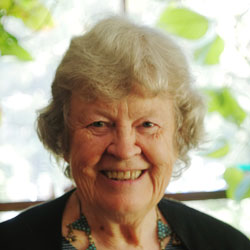
A teacher, scholar, and thinker as original and wide-ranging as Barbara Partee is rare. Currently professor emerita of linguistics and philosophy at the University of Massachusetts Amherst, Partee is one of the pioneers of linguistics—the scientific study of language, a field that has had broad impacts on everything from psychology to artificial intelligence. In particular, she has been instrumental in forging new connections between formal logic and natural language. Language is ultimately a code, encoded by a speaker to be interpreted by a listener. Partee applies concepts in logic and mathematics to untangle that code. Her work opened a new field of linguistics—she is considered a founder of formal semantics. Partee’s contributions to understanding language, in a way that envelops linguistics, philosophy, logic, and psychology, have been key shaping concepts in computer science and cognitive science.
Unicorns seem especially popular today, but Barbara Partee has been parsing unicorns for decades. Partee, a professor of linguistics at the University of Massachusetts Amherst, is a founder of the field of formal semantics. In her lectures, she likes to use the example sentence, “John seeks a unicorn.” The use of the fictional unicorn created memorable examples of how a language like English could be broken down with logic to study its meaning. Her students got the point; once, her first-year linguistics class even showed up to a lecture on Halloween sprouting paper unicorn horns from their foreheads. Partee is somewhat of a mythical unicorn herself, being a rare expert in seemingly unrelated subjects—mathematics, philosophy, and language—while also integrating psychology, computer science, and cognitive science.
As an undergraduate student at Swarthmore College, Partee was required to pick one major and two minor subjects. Her choices were math, Russian, and philosophy, although at times she didn’t see the connections between them. It wasn’t until the summer between her junior and senior year that she was introduced to linguistics and discovered that she enjoyed the challenge of taking a scientific approach to language. She was inspired to apply to graduate school, and in 1965, became the first woman to earn a Ph.D. in linguistics at the Massachusetts Institute of Technology (MIT)—with the first National Science Foundation fellowship in the field.
At MIT, Partee became a student of Noam Chomsky, the “father of modern linguistics.” (Chomsky would go on to receive The Franklin Institute’s Benjamin Franklin Medal in Computer and Cognitive Science.) In the early 1900s, language was thought to be too imprecise to be understood by mathematical logic, but Chomsky and others challenged that idea. Chomsky theorized that all languages are based on an innate human linguistic capacity and reflect a universal grammar, with variations from language to language, but consistent within a specific set of rules. For her Ph.D. thesis, Partee pursued an ambitious project—to synthesize all previous work on English syntax done in Chomsky’s transformational framework.
Before joining the faculty at the University of Massachusetts Amherst in 1972, Partee taught at the University of California, Los Angeles (UCLA). There, with two colleagues and a team of ten Ph.D. students, she was able to fulfill the original goal of her doctoral thesis work. While at UCLA, Partee became interested in the work of a colleague, Richard Montague, a logician and philosopher who pioneered the approach of treating a “natural” language—like English or any other language evolved for human communication—with the same logic-based analysis used for a “formal” language, like one designed for computer programming; he was the author of the unicorn example that became associated with his theory. The famously-acerbic Montague said that Partee was the only linguist who actually understood his work, declaring in his curious convoluted syntax, “Barbara, I think you’re the only linguist who it is not the case that I can’t talk to.”
Partee is credited with synthesizing the approaches of Montague and Chomsky—understanding the formal rules of language, while also accepting and dealing with variation in language interpretation, and applying logic to meaning. This fusion of ideas addresses how meaning and structure come together in language. Partee also developed an analytical method for deriving the variety of meanings many expressions can have, a method exemplified by what is now commonly called the “Partee Triangle.”
Partee’s work has been honored by the 2018 British Academy’s Neil and Saras Smith Medal for Linguistics, the Linguistic Society of America’s 2016 Victoria A. Fromkin Lifetime Service Award, and the 1992 Max Planck Society’s Max-Planck-Forschungspreis award (with Hans Kamp). She is a fellow of the American Academy of Arts and Sciences, the American Association for the Advancement of Science, the National Academy of Sciences, the Linguistic Society of America, the Royal Netherlands Academy of Arts and Sciences, and the British Academy.
For decades, Barbara Partee has brought together diverse fields like philosophy, psychology and logic to help us understand language. Starting from a simple sentence about a unicorn, she has revealed unexpected insights into the complexity of human communication.
Symposium: The Past, Present And Future Of Formal Semantics
Watch Part 1 | Watch Part 2
Information as of March 2020

